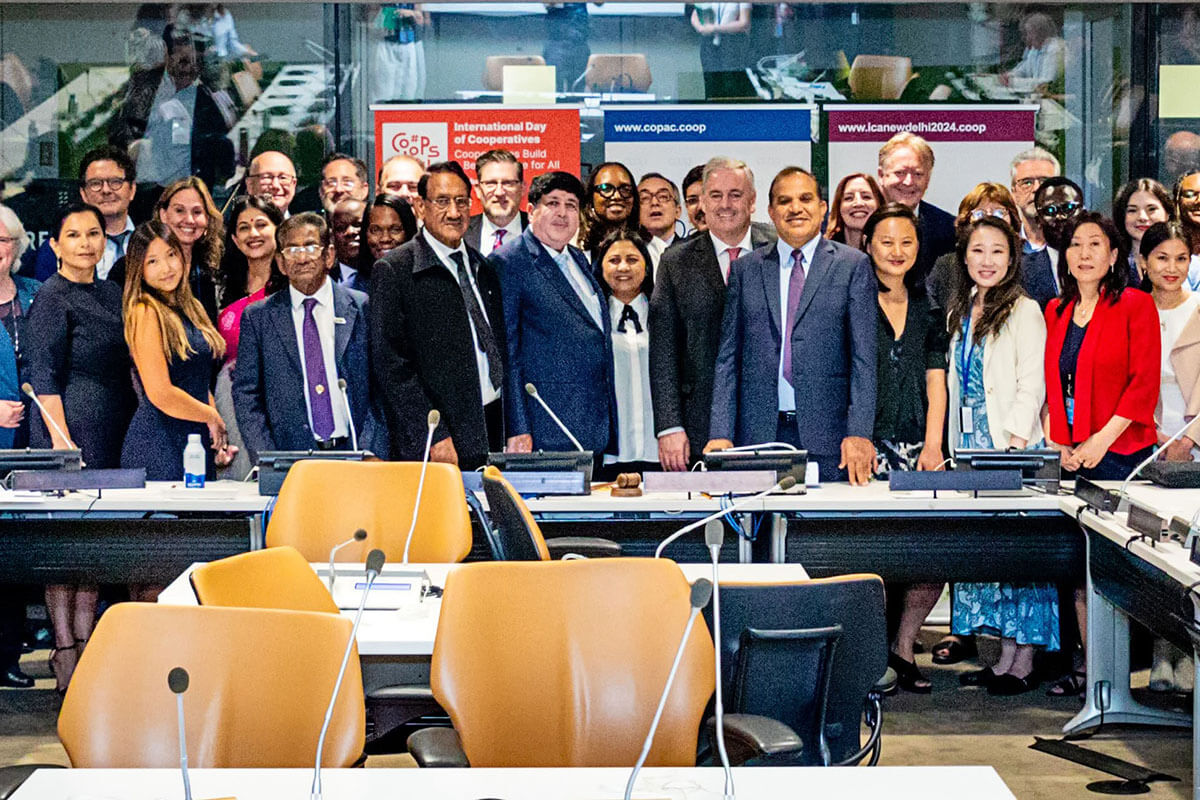24 May 2023
Speech for the launch of Mutual Value Measurement©, The Shard, London, 23 May 2023
Melina Morrison, CEO Business Council of Co-operatives and Mutuals
Good afternoon, it’s wonderful to be here with our UK and European colleagues. Thank you for your time.
Firstly, can I thank you all for coming today. Time is a precious resource, and we value yours.
I would like to thank Professor Yuval Millo and Warwick University for hosting us today in this exceptional place. It’s lovely to look around the room and see many familiar faces. I’m immensely proud to be representing the Australian co-op and mutual movement and the peak body, the Business Council of Co-operatives and Mutuals.
I’m pleased to be here with our Australian research partners, Dr Paul Thambar and Monash University School of Business and our long-term partners and colleagues, Mutuo – without Peter [Hunt] and Mark [Willetts] we would not be here together today. I’m grateful to our MVM practitioners, Matt Rutter all the way from Australia [GFC], Andrew Haigh [Newcastle Building Society], and Anne Gergen [AGRiP, US] here today and online, to share their ‘MVM’ journey. I’m very grateful to Rose Marley [Co-operatives UK], Robin Fieth [BSA] and Andrew Whyte [AFM] for joining our industry panel.
It’s exciting to be here to share with you what we believe is a break-through methodology for surfacing our mutual difference and shining a spotlight on our way of doing business. Against a backdrop of recessionary winds, inflation and a cost of living crisis that is seeing increasing numbers falling into poverty, with geo-political tensions ratcheting and the climate crisis sharpening to the predicted emergency, there’s not a minute to lose. People are hungry for business models that ‘do business’ with purpose. Our business model is not only fit for the times, but also vital for the future.
There’s lots to be dystopian about, but here in this room I sense a mood of optimism. In Mutual Value Measurement© terms, we call this ‘mutual mindset’ (more on that later).
Colleagues, I have never met a co-operative or mutual leader who didn’t innately know the value of mutuality and co-operation when powered by business. Today we’re here to share knowledge and insights into the Mutual Value Measurement Framework©, but on a more philosophical level, we’re here to question why we so often leave our stories at the watercooler, or in the ‘Teams’ chat. Those powerful anecdotes and examples that exemplify our mutual business purpose. MVM is predicated on a simple premise – The value creation of co-ops and mutuals is real, intrinsic to the business model – not an add on or virtue signaling. It can be measured, and it can be communicated. MVM is an industry response to the seemingly intractable problem that co-ops and mutuals are the square peg to the round holes of impact measurement. Able to fit in, but not perfectly.
In nearly two decades working in the co-op and mutual sector, I have been fascinated and frustrated to discover that co-ops and mutuals everywhere (certainly in the places I have had most to do with the movement) share a common challenge in not being able to measure and articulate the total value they create in ways that are understood, recognised and valued by their stakeholders.
This problem is seen in the gap between the ubiquity of co-ops and mutuals, the scale of the movement, and the visibility and awareness of the business model. In Australia, we have measured this twice in 10 years with the same findings. 8 in 10 Australians are members of at least one co-op or mutual, only 3 in 10 know that.
We know that this is a missed opportunity by the quantum of investment in expensive advertising by other business sectors selling their ESG or sustainability credentials – essentially ‘mutual washing’ their business purpose. All businesses, if we are to heed the billboards are in the business of shared value, building ‘communities’ and serving ‘members’. How can we, as stakeholder businesses, claim some of this territory back, if not be the leading and original ESG businesses?
It is a well-worn adage that what gets measured, gets monitored and what gets monitored gets valued. Valuing the positive impact of cooperatives and mutuals on their members, their customers, their communities and wider society, is long overdue. Mutual Value Measurement© is a framework that makes sure none of the value co-ops create is hidden, overlooked or ignored.
It is designed specifically for our business models not predicated on a different starting position about what is a business. It is therefore customised to our unique characteristics and does not require thought reshaping to fit a less aligned framework.
The research team built the framework bottom up through an embedded research methodology – they interviewed more than 200 people asking 3 consistent questions: How does your CME create value? How is this measured? And how is it communicated?
The rigorous field-testing has been borne out in the variety of CMEs applying the MVM Framework in different industries and cultural settings.
MVM is more than an impact measurement framework. It is used by co-ops and mutuals as a starting point for articulating business purpose, developing or refreshing strategies and through this new KPIs for the business and its people. Clarifying purpose has led to being able to articulate the benefits of the business better and more clearly for key stakeholders.
An emerging exciting trend is the use of MVM to enhance ESG and sustainability reporting, building a bridge between the measures by which a business commits to track it’s ESG performance.
A US project is developing the framework as an aggregation tool for meaningful benchmarking. (Ann Gergen is here to share this with us).
We are beginning to see the communications advantage of a more widely recognised symbol of Mutual Value. We are at the beginning of MVM Accreditation™ – which is a peer assessment process to steward good use of MVM for the long term benefit of the framework.
We might allow ourselves to imagine a Mutual Value symbol with the power and meaning of the Fairtrade or B Corp mark.
In the last half of my presentation, I would like to take a few minutes to share the Framework in more detail with you.
The MVM Framework uses six dimensions of mutual value to express the value created by co-ops and mutuals. These are commerciality; shaping markets; member relationships; community relationships; ecosystem and reciprocity; and the sixth dimension, which is also a foundation stone of the entire framework, is mutual mindset.
The balance of the dimensions is customised to account for the unique characteristics of the co-op or mutual, but all dimensions create value as a wholistic framework interdependent and crossing-over each other. It is the wholistic nature of the unique balance of dimensions in a framework that provides the bridge to the organisation’s sustainability.
Finally, incorporating MVM into impact measurement, strategy and setting KPIs, helps a co-op or mutual to identify the total mutual value created, which can track performance over time.
We know that co-operatives and mutuals seek to create a virtuous circle through their business performance. The whole point is to create long term relationships with members to drive the core business. This enables the commercial success which itself facilitates further member and community activity.
Each mutual is a kind of mini society where the business regenerates itself through its actions. Where this works well, we can see many long-lived co-operative and mutual businesses, because there is no end point.
When we apply this to the traditional linear way of viewing business performance, we can see how MVM fits in. Each stage is important and necessary.
Too often when people try to describe their co-operative or mutual, they talk about how it is structured. This is a bit too instrumental because it is crucial to describe WHY it exists, and what led to its creation. And putting this into a modern context.
Fundamentally, MVM is all about ensuring that the mutual business purpose is being delivered through the corporate strategy. We identify mutual value statements to clarify what positive impact we expect our mutual business to create. But we need to have mutual performance indicators to measure and track this impact, whether quantitative or qualitative. Each of these acts as a proof point for the mutual value statements. Proof points become marketing messages that are verifiable statements of fact not mere marketing.
Once we decide which measures matter most to us and our business purpose, these provide the basis for our reporting – annual reports, impact reports, sustainability reports. The data is drag and droppable into these.
As I said before, MVM Accreditation is a stewardship process designed to identify and credential good MVM practice. As the MVM Mark gains visibility so to does the visibility of the business model. MVM has its own website and MVM Accredited organisations are invited to join a Community of Practice sharing insights, case studies and ideas about MVM.
MVM has been developed by the sector for the sector. As part of a global movement, we want to protect the framework for the exclusive use of co-ops and mutuals, so it is protected IP. It is essentially freely shared with a contribution (licence) fee designed to reinvest in the development of the Framework and to pay for people’s time.
Thank you for your time.
More information
- Read the full launch media release, European launch for world first framework to measure co-operative value
- View the launch photo gallery
- Watch Andrew Haigh, Newcastle Building Society CEO, talk about Mutual Value Measurement©
- Visit the Mutual Value Measurement© (MVM) website


